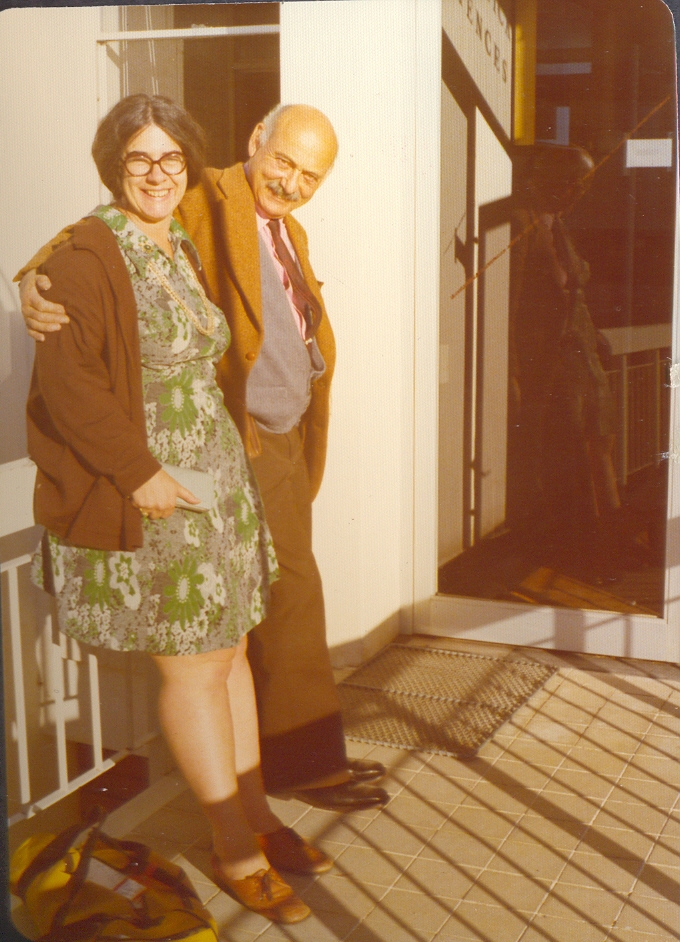- About MAA
- Membership
- MAA Publications
- Periodicals
- Blogs
- MAA Book Series
- MAA Press (an imprint of the AMS)
- MAA Notes
- MAA Reviews
- Mathematical Communication
- Information for Libraries
- Author Resources
- Advertise with MAA
- Meetings
- Competitions
- Programs
- Communities
- MAA Sections
- SIGMAA
- MAA Connect
- Students
- MAA Awards
- Awards Booklets
- Writing Awards
- Teaching Awards
- Service Awards
- Research Awards
- Lecture Awards
- Putnam Competition Individual and Team Winners
- D. E. Shaw Group AMC 8 Awards & Certificates
- Maryam Mirzakhani AMC 10 A Awards & Certificates
- Two Sigma AMC 10 B Awards & Certificates
- Jane Street AMC 12 A Awards & Certificates
- Akamai AMC 12 B Awards & Certificates
- High School Teachers
- News
You are here
Who's That Mathematician? Paul R. Halmos Collection - Page 59
For more information about Paul R. Halmos (1916–2006) and about the Paul R. Halmos Photograph Collection, please see the introduction to this article on page 1.
Mathematicians from the Collection ... and Their Friends!
Israel 1974
Two mathematicians whose photographs have already appeared more than once in this collection …
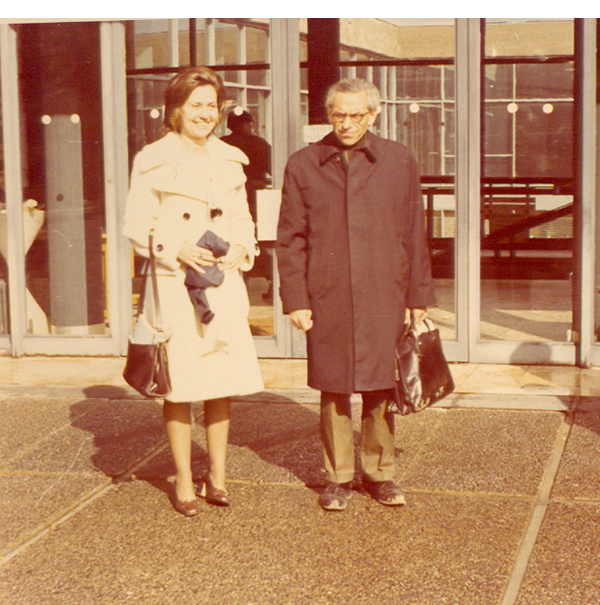
Alexandra Bellow and Paul Erdős (1913–1996) were photographed by Ivan Singer in Haifa, Israel, in 1974.
The Romanian functional analyst Ivan Singer recalled recently that he visited several universities in Israel and Greece during the winter holiday in 1974, in the midst of a six-month visit to the University of Amsterdam, Holland. The invitation to visit Israeli universities came from Samuel Karlin (1924–2007), who was Head of the Department of Applied Mathematics at the Weizmann Institute in Rehovot, Israel, at the time. (Karlin was a longtime Stanford University mathematician who divided his time between Stanford and the Weizmann Institute from 1970 to 1976 or later.) Photographs of (and by) Ivan Singer appear on page 36 and page 58 of this collection, where you can read more about him. Ergodic theorist Alexandra Bellow also is pictured on page 5 and page 9 of this collection, where you can read more about her. Photographs of polymath Paul Erdős appear on page 3, page 14, and page 27 of this collection.
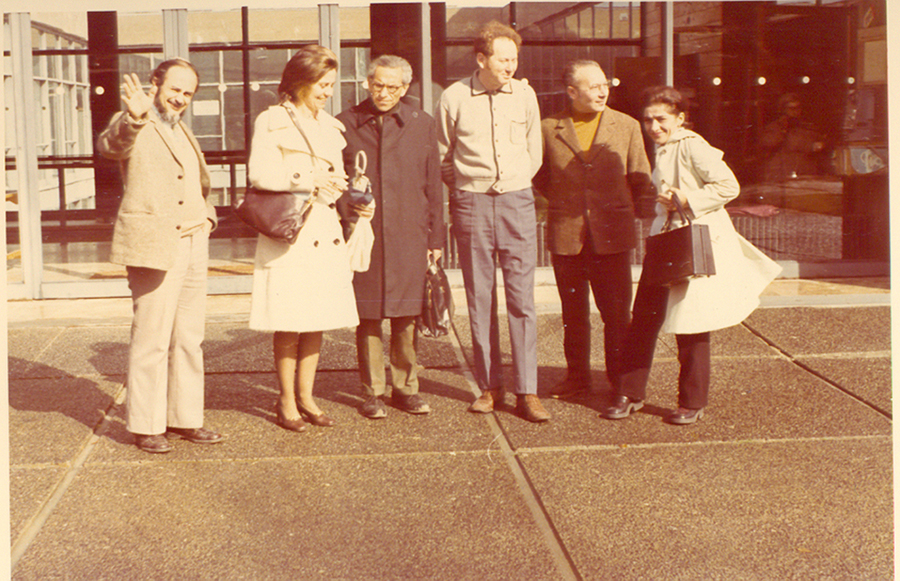
Left to right: Pierre Saphar, Alexandra Bellow, Paul Erdős, Harry Cohn, Froim Marcus, and, at far right, Crina Singer (wife of Ivan Singer)
Pierre-David Saphar is Professor Emeritus of Mathematics at the Technion – Israel Institute of Technology in Haifa, Israel. Singer remembers discussing Saphar's then recent work on tensor products of Banach spaces with him during a visit to his home in Haifa. According to MathSciNet, Pierre Saphar published articles on various topics in functional analysis, primarily Banach spaces, from 1960 to 1999. (Sources: Technion Mathematics, MathSciNet)
Harry I. Cohn, a probabilist specializing in Markov chains, earned his Ph.D. in 1966 from the University of Bucharest, Romania, but has spent most of his career at the University of Melbourne, Australia, where he is now retired from the Department of Statistics. He was at the Centre for Mathematical Statistics in Romania from 1963 to 1970; at the Technion – Israel Institute of Technology in Haifa, Israel, from 1970 to 1974; at Haifa University during 1974–75; at the Australian National University in Canberra from 1975 to 1978; and at the University of Melbourne, Australia, from 1978 onward.
Froim Marcus was a Romanian-born differential geometer who had at least some association with Technion – Israel Institute of Technology in Haifa, Israel, during the 1970s and early 1980s, publishing several papers in Technion’s preprint series from 1971 through 1981. According to MathSciNet, he published papers, most of them on projective differential geometry, in many languages and journals from 1958 to 1985. (Sources: GoogleBooks, MathSciNet)
Ivan Singer especially enjoyed meeting with fellow functional analysts during his visit to Israel, including Joram Lindenstrauss and others in Jerusalem.
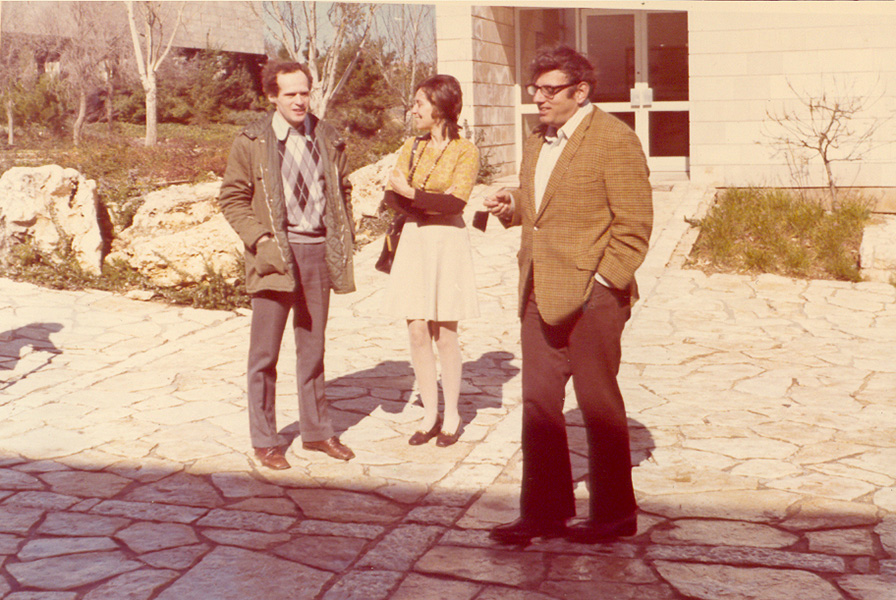
Left to right: Andrzej Szankowski, Alexandra Bellow, and Joram Lindenstrauss
Andrzej Szankowski is Professor Emeritus of Mathematics at Hebrew University of Jerusalem. He collaborated with Lindenstrauss during the 1980s and has published on Banach spaces since 1969. (Sources: Hebrew University Mathematics, MathSciNet, Mathematics Genealogy Project)
Alexandra Bellow is pictured above, where you can find links to more information about her.
Joram Lindenstrauss (1936–2012) earned his Ph.D. at Hebrew University of Jerusalem and spent his career there as well. He and his thesis advisor, Aryeh Dvoretzky (1916–2008), founded the school of functional analysis in Israel. (Sources: Mathematics Genealogy Project, Scripta Mathematica, MacTutor Archive)
Singer also enjoyed meeting with approximation theorists, as the following photograph shows.
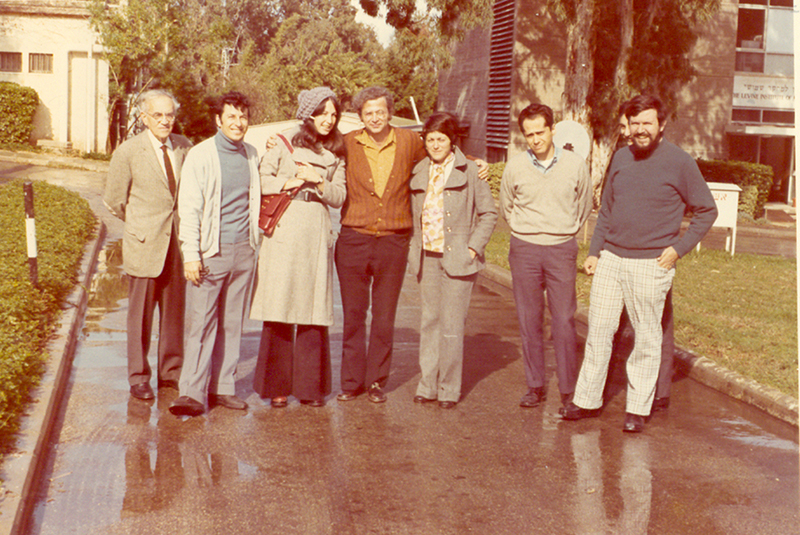
Left to right: Isaac Schoenberg, Dany Leviatan, Nira Dyn, Samuel Karlin, Esther Kimchi, Charles Micchelli, and Zeev Ditzian were photographed by Ivan Singer at the Weizmann Institute of Science in Rehovot, Israel, in 1974.
Isaac Schoenberg (1903–1990) is pictured on page 47 of the collection, where you can read more about him.
Dany Leviatan is ProRector and Professor Emeritus of Pure Mathematics at Tel Aviv University in Israel. An approximation theorist, he earned his Ph.D. in 1966 from Hebrew University in Jerusalem and has been on the faculty of Tel Aviv University since then. He served as Rector of Tel Aviv University from 2005 to 2010 and has been ProRector since 2011. (Sources: Mathematics Genealogy Project, Tel Aviv University Mathematics)
Nira Dyn is Professor Emeritus of Applied Mathematics at Tel Aviv University. She earned her Ph.D. at the Weizmann Institute of Science in 1970 with the dissertation, “Optimal and minimum norm approximations to linear functionals in Hilbert spaces, and their application to numerical integration.” At her webpage, she lists nonlinear subdivision schemes and approximation of set-valued functions as her current research interests. (Sources: Mathematics Genealogy Project, Tel Aviv University Mathematics)
Samuel Karlin (1924–2007) earned his Ph.D. in 1947 from Princeton University with the dissertation “Independent Functions” written under advisor Salomon Bochner. His first faculty appointment was at the California Institute of Technology (Caltech) in Pasadena, where he initially published in functional analysis but soon switched to game theory. In 1956, he moved to Stanford University. His interest in game theory led him into mathematical economics and operations research and, by the mid-1960s, into stochastic processes and total positivity. By the late 1980s, he had begun to apply mathematics to biology. He spent the rest of his career at Stanford University, with additional affiliations at the RAND Corporation and, as noted above, at the Weizmann Institute of Science in Rehovot, Israel. He may be best known today for his work on DNA sequencing. (Sources: Mathematics Genealogy Project, MacTutor Archive, Stanford University News Service)
Esther Kimchi earned her Ph.D. in 1976 from Tel Aviv University in Israel with the dissertation, “Problems of Interpolation and Their Application in Approximation with Side Conditions,” written under advisor Dany Leviatan. She co-authored a series of eight papers with Nira Dyn from 1974 to 1979, and has pursued a career in industry. (Sources: Mathematics Genealogy Project, MathSciNet)
Charles A. Micchelli earned his Ph.D. in 1969 from Stanford University with the dissertation “Saturation Classes and Iterates of Operators,” written under advisor Samuel Karlin. According to Singer, Micchelli “became a well known specialist in splines and optimal recovery.” He is Professor of Mathematics at the State University of New York at Albany (SUNY Albany), where his current research interest is computational mathematics and its applications. He wrote recently,
I do remember Ivan Singer's visit. I was put in charge of taking care of him while he was in Israel by my thesis adviser Samuel Karlin. … I still have fond memories of my visit to Israel just after the Yom Kippur War in 1973 with my wife, Pat; my son Craig, who was three at the time; and my daughter Lisa, who was one year old.
(Sources: Mathematics Genealogy Project, SUNY Albany Mathematics)
Zeev Ditzian received his Ph.D. in 1965 from Hebrew University in Jerusalem. He was on the faculty of the University of Alberta in Edmonton, Alberta, Canada, from the early 1970s onward, and he is now Professor Emeritus of Mathematics there. He continues to do research in approximation theory. (Sources: Mathematics Genealogy Project, University of Alberta Mathematics)
Israel 1960
Mathematical physicist Daniel Sternheimer alerted us to the following extraordinary photograph that includes many mathematicians pictured elsewhere in this collection, plus many more.

The participants in the 1960 International Symposium on Linear Spaces held July 5–12 at Hebrew University in Jerusalem, posed for the camera of an unknown photographer. Identifications of participants were made over a five-year period (2007-2011) by Lech Maligranda of Luleå University of Technology (LTU) in Luleå, Sweden.
Lech Maligranda has published the results of his identification project in Cornell University Library’s arXiv as “Fifty two years ago in Jerusalem,” and here in MAA Convergence with the hope that our readers can help him identify three remaining conference participants. Two of these three mystery persons are labeled 1 and 2 in the photo above (and 19 and 32 in the photo at arXiv).
1 – top row, second from left, between Sternheimer and Kaplansky
2 – top row, middle, between Klee and Helson and behind Berger-Burak
Maligranda has identified the person labeled “3” in the photo above as Haim Amsterdamer. As noted, the person labeled “4” has been identified as Frank Bonsall (see page 7 of this collection for another photo of Bonsall).
Maligranda’s third mystery person? He (or she) is fourth from top right, between Nachbin and Reichbach.
According to Sternheimer, about whom you can read more on page 14 of this collection (see the caption for Leopold Flatto) and who is at upper left in the photo above:
I have many fond recollections and interesting anecdotes about the many mathematicians (and physicists) I met during a career in research that … started in 1960 in Jerusalem. I was then barely 22 (an M.Sc. student) and attended a conference on linear spaces, as proved by a photo I received in October-November 2011 from Lech Maligranda. Maligranda had been a student of [Wladyslaw] Orlicz and found on the Internet (with an incorrect reference) [this] photo, for which he has been able to put a name on almost all faces (or fractions thereof).
Dany Leviatan (see the fourth photo on this page, above) also remembers this conference. He was a first year student at Hebrew University at the time. More recently, he helped Maligranda identify several of the participants, including Haim Amsterdamer (person "3" in the photo). Leviatan recalled recently that Amsterdamer taught him analytic geometry during his first year at Hebrew University, but then left mathematics two years later in order to study psychology. Leviatan wonders what became of Amsterdamer afterwards, and would appreciate any information about him.
Finland 1978
Ivan Singer sent us the next two photographs, each including himself, one other mathematician who has already appeared in the collection, and one mathematician new to the collection.

Left to right: Angela Vasiu, Ivan Singer, and Robert “Bob” Bartle enjoyed the International Congress of Mathematicians, held in Helsinki, Finland, in 1978.
Angela Vasiu was on the mathematics faculty at Babes-Bolyai University, Cluj-Napoca, Romania. More information about Vasiu would be appreciated.
For more information about Ivan Singer, see page 36 and page 58 of this collection.
Bob Bartle is pictured on page 4 of this collection, where you can read more about him.
Germany 1982

Left to right: Laszlo Lovasz, Bernhard Korte, and Ivan Singer at the 11th Symposium on Mathematical Programming in Bonn, Germany, in 1982
Laszlo Lovasz is pictured on page 31 of this collection, where you can read more about him.
Bernhard Korte is Director of the Research Institute for Discrete Mathematics in the Hausdorff Center for Mathematics at the University of Bonn, Germany. The Institute currently specializes in combinatorial optimization and chip design within its larger purview of algorithms, combinatorics, and complexity. Korte and Lovasz wrote a series of papers on “greedoids” during the 1980s, culminating in a Springer book on the topic in 1991 (Greedoids, with Rainer Schrader, who was a 1982 Ph.D. student of Korte). Now based at the Eötvös Loránd University in Budapest, Hungary, Lovasz has been an honorary member of the Research Institute for Discrete Mathematics since visiting the University of Bonn during 1984-85. (Sources: Research Institute for Discrete Mathematics, MathSciNet, Mathematics Genealogy Project)
For more information about Ivan Singer, see page 36 and page 58 of this collection.
Australia 1976

Ivan Singer photographed graph theorist Frank Harary (1921–2005) at a wildlife preserve in Brisbane, Australia, in 1976. Harary is pictured on page 29 of this collection, where you can read more about him.
Singer visited at least a dozen Australian universities across the continent during a two-month visit there, the main purpose of which was to give an invited address at the Annual Congress of the Australian Mathematical Society in Perth.
Jennifer Seberry and Bernhard Neumann, probably at the Australian National University in Canberra, where Seberry was a research fellow and Neumann a professor in the mathematics department
Jennifer Seberry is Professor of Computer Science at the University of Wollongong, Australia. She earned her Ph.D. in computational mathematics from La Trobe University in Melbourne, Australia, in 1971. During her career, she has done pioneering work in combinatorial matrices and designs, cryptology, and computer security. (Sources: Mathematics Genealogy Project, University of Wollongong Computer Science)
Bernhard Neumann is also pictured on page 37 of this collection, where you can read more about him. Singer especially remembers playing cello duets with Neumann during his visit.
United States 1999–2000
Do you know the first and last names of the mathematicians in the photos below? Do you know their middle names?

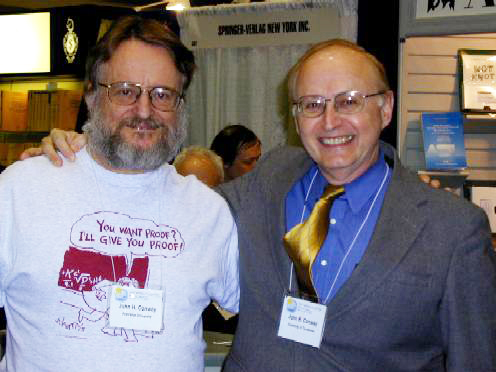
Mathematicians John H. Conway, left in each photo, and John B. Conway provided photographic evidence that they were (and are) indeed two different people (top two photos by Ina Mette).
The first two of these three photographs were taken in January of 1999 at the Joint Mathematics Meetings in San Antonio, Texas, by Ina Mette, of the American Mathematical Society. About the last photo, John H. Conway remembers that it was taken in January of 2000 at the Joint Mathematics Meetings in Washington, D.C., where:
Someone asked me, "Are you THE John Conway?", and, without looking up, I said, "It depends which John Conway you mean!" A good reply, because the asker was John B!
Their full names are John Horton Conway and John Bligh Conway. Another photograph of John B. Conway appears on page 49 of this collection, where you can read more about him; you’ll also find photos of him on page 58 of this collection.
John H. Conway (1937–2020) earned his doctoral degree in 1964 from the University of Cambridge with the dissertation “Homogeneous ordered sets,” written under advisor Harold Davenport. He joined the Cambridge faculty that year and in 1968 published his results on the symmetry group of the [John] Leech lattice, which included three new simple groups as a factor group and subgroups. In 1970, Martin Gardner (see page 16 of this collection) popularized Conway’s “Game of Life” in his Scientific American column. That same year, Conway, while studying the game of “Go”, invented what became known as the surreal numbers. These numbers were named by Donald Knuth in his book Surreal Numbers in 1974, the year this photo was taken. In 1986, Conway moved from Cambridge University to Princeton University, where he assumed the John von Neumann Chair of Mathematics and where he remains on the faculty today. (Source: MacTutor Archive; see also T&F Virtual Special Issue)
Many thanks to Ivan Singer, Daniel Sternheimer, Lech Maligranda, Ina Mette, and John B. Conway for this week's photographs. For more information about Paul R. Halmos (1916–2006) and about the Paul R. Halmos Photograph Collection, please see the introduction to this article on page 1.
You may use the photographs on this page in your classroom; for all other purposes, please contact MAA Convergence Editor Janet Beery so that she may seek permission for you from Singer, Maligranda, Mette, or Conway.
Janet Beery (University of Redlands) and Carol Mead (Archives of American Mathematics, University of Texas, Austin), "Who's That Mathematician? Paul R. Halmos Collection - Page 59," Convergence (June 2013), DOI:10.4169/loci003801

